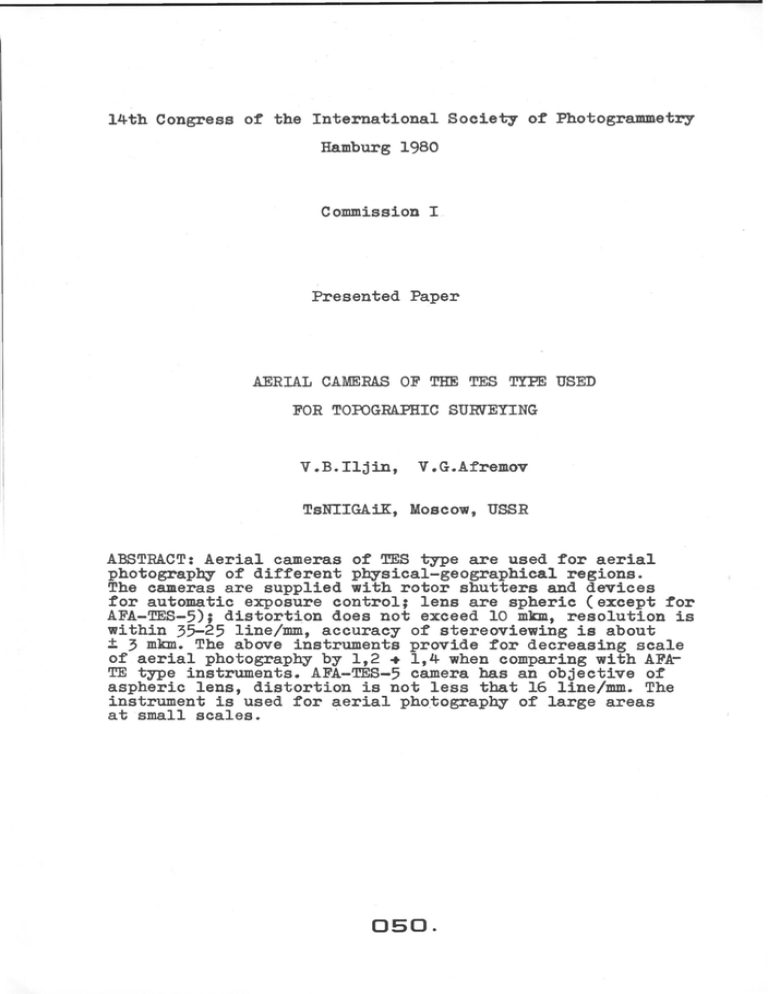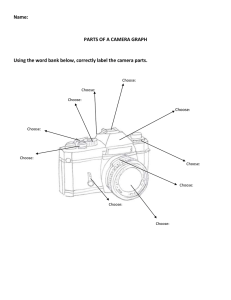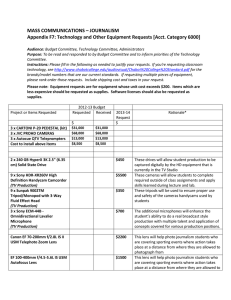14th Congress of the International Society ... Hamburg 1980 C ommission Presented Paper
advertisement

14th Congress of the International Society of Photogrammetr.y Hamburg 1980 Commission I . Presented Paper AERIAL CAMERAS OF THE TES TYPE USED FOR TOPOGRAPHIC SURVEYING V.B.Iljin, V.G.Afremov TsNIIGAiK, Moscow, USSR ABSTRACT: Aerial cameras of TES type are used for aerial photograpby of different pbysica1-geographical regions. The cameras are supp1ied with roter shutters and devices for automatic exposure eontro1; 1ens are spherie (exeept for AFA-TES-5); distortion does not exceed 10 mkm, reso1ution is within 35-25 1ine/mm, accuracy of stereoviewing is about ± 3 mkm. The above instruments provide for decreasing sca1e of aeria1 photography by 1,2 + 1,4 when comparing with AFATE type instruments. AFA-'l'ES-5 camera bas an objective of aspheric 1ens, distortion is not 1ess that 16 line/mm. The instrument is used for aeria1 photograpby of 1arge areas at sma11 sca1es. · 050. I I Aerial ca.mera.s AFA-TES with foeal 1.engths 350,100, ?0 and 50 mill and angular fields 40,103,120 .a nd 136,50 respeetively, the pieture shape being 18 x 18 em, have been developed in the USSR. They have new lenses that enable to improve metrie and image qualities of pietures, and an exposure automatie system with a rapid rotor shutter Pieture mistakes can be fixed. The quality of pietures is influenced by the fo~lowing factors: photogrammetric distortion of the aerocamera, characteristics of shutters, nonflattening of the film and its deformation, correction quality of the optical system, image motion etc. The distortion effect decrease is achieved by reduction of the symmetrical radial and eolour distortion in calculations of wide-angle camera lenses and by improving their manufacture teehnology whieh enables the calculated data to be reprodueed more accurately and tangent and asymmetrical distortion to be lowered. Th~ calculated distortion of the lenses of the new aerial cameras is up to 5~m. The real distortion of all cameras, except TES-5, is not more thaa lO~m. In developing the new-lenses special attention was paid to eliminating ehromatie and monochromatic aberrations. In this respeet some progress bas been made: in the. new cameras the chromatic difference ef magnification characteristic o~ "eolour" distortion does not exceed 0.02 mm. The geometrical distort~ons eonneeted with the operation of the shutter were eliminated by using the eentral shutters placed very close to the aperture diaphragm or in the plane optically eonjugated with it. The imag~ quality is strongly influenced by the image geometrical motion dependent on the image movement rat~ and exposure. The rapid shutters in TEStype eameras enable to obtain rea'l exposure up to 1/'700 s. The short exposures provide images essentially without effects of the geometrieal image motion. The shutters of the new eameras are principally the same, they differ only in leaf sizes dependent on the diameter of the aperture covered,. its maximum size being 35 mm. The exposure control is performed by changing the number of the electric motor turns in proportion with the variation of the integral brightness of ~he terrain. The proportionality coefficient is determined by the two param&ters: a relative aperture or a lens and by the ratio of the film actinism to the filter factor. Automatical exposure eontrol (AEC) in cameras of T:EB-type is performed with the help of a photoelectrie exposuremeter eonsisting of a unit with a photo-cell and a regulator of turns of the eleetric-motor shutter. Changing the proportionality coefficient is achieved by varying the sensitivity of photoelectric exposuremeter. The results of the tlying test showed that in the case of photograpby of medium eontrast terrain (plain, toot-hills,etc) root mean fquare deviation of integral density ot negatives is wi thin ~ ?-10%. During photograph:y of the areas wi th considerable fluetuations of landscape brightness (mountain regions) the deviations are ! 12-16%. 05::1.. The film flattening in eameras of TES-type is made by pressing it to the glass plate (foeal lengths are 50,70 and 100 mm) that has ealibration marks making it possible to fix residual errors due to nonflattening and deformation of the film. To inerease the aecuraey of film flattening a steady stretch of the film is provided before the exposure and at the time of photography by using an electromagnet friction unit with variable momentum and by pressing the film to the glass with an elastic slab. Studies of the film flattening aeeuraey were carried out with an interference unit. They showed that under laboratory conditions the medium deviation of the film from the glass surface regardless of its type and a flattening method is -± 5-6 f' m. The new series consists of the following cameras: AFA-TES-5, AFA-TES-7, AFA-"TBS-10 and AFA-TES-35· All the cameras, except AFA-TES-5, are provided with removable filters yellow, orange and transparent . The smoothtng of illumination is performed by depositi~g a shading coat on the filter surface . · Camera AFA-TES-5 is ihtended for photography of large areas in small scales, mainly for geological mapping in the scales 1: 100 000- 1: 200. 000.- It is provided with Russar-62 lens with aspheric optl.cs. The lens has a constant yellow filter. The main optical · charaeteristics of the camera are given in Fig.l, where Ia is the principal op_tical scheme, I b is the resolution on panchromatic film of 22-type with the total aperture obtained with absolute contrast mires in meridian /M/ directions , an.d .- tangertial /T/ direetiQn, ·x ·e ,is __the.· average radial distortion. · T~e aspherie lens enabled to improve illumination in the image plane at the eamera angle up to 136.5°. But the difficulty of making aspherie surfaee did not allow to deerease photogrammetric distortion to the values suitable for preeise photogrammetrie measurements. For the test samples the maximum photogrammetrie distortion is 0.05 mm, for the commereial ones it is 0.1 mm. Ver,y wide angle cameras AFA-TES-5 due to their large angle and high image quality are used sueeessfully and enable to obtain a new type of geologieal information in studying stretched and weak struetures. Camera AFA-TES-7 is intended for photography of plain areas for the purpose of topographie mapping in the seale 1: 10 000 and larger. ·rt is provided with Russar-80 lens whose foeal length is 70 mm, angle of view is 12oo, the relative aperture is 1: 6.8. The main optical eharaeteristics of AFATES-7 are presented in Fig.2. · Camera AFA-TES-10 is intended for photography of hill areas in different seales. It is · provided with Russar-71 lens whose foeal length is 100 mm, angle of view is 1030 and relative aperture is 1: 6.8. The main optical eharaeteristies of AFA-TES-10 are presented in Fig.3. Camera AFA-TE-35 is intended for photography of montain regions, towns and loealities. It is provided with Russar-68 lens, whose foeal length is 350 mm, angle of view is 400 and relative aperture is 1:7. The eamera enables the central rotor 052. shutter to be used, the magnification in lens pupils being 0.7. Due to this, with relative aperture being 1:7, the diameter of the aperture diaphragm, and theräfore the shutter aperture are equal to 35 mm. The main optical characteristics of AFA-TE-35 are given in Fig.4. In camera AFA-TE-35 vacuum flattening of the film to the plane at the time of exposure is used. The choise of th•s method is due to the fact that images obtained with AFA-TE-35 are mainly intended for making photoplans with high enlargement when negatives defects caused by mechanical damages of the glass and photographic layer that are inevitable in pressing the film to the glass, dateriorate the quality of negatives noticeably. And one need not use register-glass reseau. App1ication of the said new cameras makes it possib1e to decreas-e air survey scale in 1, 3 times to conventiona1 cameras due to improving air photo quality only. The main technica1 characteristics of cameras of TES-type are given in the tab1e. TABLE The main characteristics of the TES-type cameras Parameter • • . . • • • . :units:TES-5 :TES-5M :TES-7 Focal length mm degree Camera angle Relative aperture Illumination 50 50 136.5 70 120 1:6.8 1:9 Cos1 • 4 Bp Cos2 • ?ß Stereoscopic fusion accuracy fY'm :!:3.3 Resolution not 16 less than 1/mm Photogrammetric dispersion not 100 more than f'm 1/80 Exposure range s 1/70 -1/?00 -1/240 2.4 Cycle time s 2.4-1.4 Register-glassyes reseau yes no AEC 053. ..·TEs-1o· .• TE-35 • 100 103 350 40 1:6.8 1:7 Cos 3ß Cos4.?Bß ±3-5 ±3~0 ±2.8 25 30 35 10 1/70 -1/700 2.41.4 10 1/70 -1/700 2.41.4 10 1/?0 -1/700 2.4- yes yes yes yes no yes 1.4 0~~~~--~---~~~~~~ · Z'mm -1o C) Fig.1.Russar-62-9/50 lens a) principal ~ptical scheme b) resolution c) averege radi~l distortion Rl/mm M a) , .dZ~m -+I o~--~~~~--+---~~~-.­ z~", C} Fig.2.Russar-80-6.8/70 lens al principal optical scheme b resolution c average radial distortion 054. .Re/mm 0~------~~------~----~ 2S b) so c) Fig.3.Russar-71-6.8/100 lens a) principal opt:ical ::;cheme b) resolution c) average radial distortion Rt/mm OL-~----+-------+------+ 20 b) ß a.) "l'mm _., c) P1g.4.Rusear-68-7/~)0 lnns alprincipal optical scheme b reHolution c av~ra~e radial di~tortion oss. Ref'erences I.,lilnHH B.B. 11 HOBhiM aapo!floToannapaT A<bA-T9C-IO". reo;neSHH H Kap!orpa!fl~H, ~ 4,!969, c.45-4?. 2.A!flpeMOB B.r. Illn:&HH B.B. "HoBhle Tonorpa!flH"iecKHe aapoQ)oToannapa!N AtA-T9C.-? m A~A-T9-35t'. reo;n;esHs: H KapTorpa!flHH, ~ 6, I9?6, c.4I-44. · 3.lill1bHH B.E. 11 ABTOM8!H'q6CK06 perynupo:paHHe SKCfl08HitHH B aapo!flo!oannapa!ax A~A-T9Y H A~A-T9C • reo;n;eaHH H KapTorpa!flHH, ~ 6, I9?0, c~49-53. . · 4.HeHameB lil.C." lilHTep~PepeHitHOHHhlä M6TO;ZJ;·KOHTP0llfl BbipaBHHB8HHH aaponneHKH B aapoq>oToannapaTax". reo;nesHH H KapTorpa!flHa, ~ 8, !964, c.46-4?. . 5.PyCHHOB M.M. H ;np. ajc ~ 355592, E.lil. ~ 3I, I9?2. 6.AraJIJpuo:aa H.A. "Illccne;n;o:aaHHe HOBoro o6~eKTHBa Pyccap-?I". reo;neaHa H KapTorpa!flHs:, ~ IO,.I9?9, c.4?-48. 11 056.





